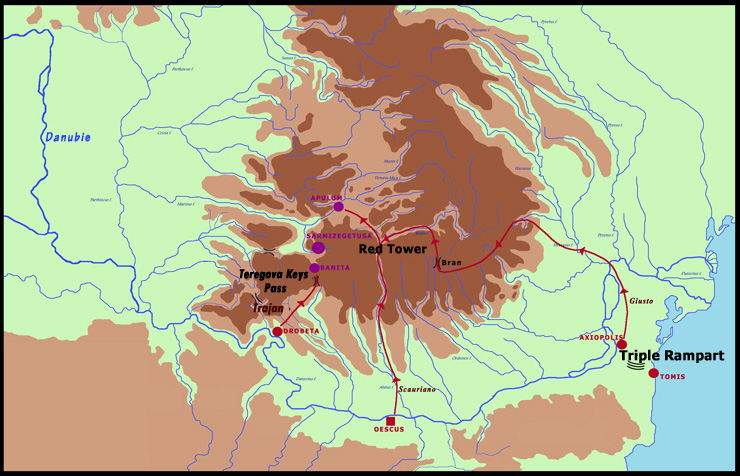DE BELLO DACICO - V DACIAN CAMPAIGN
Trajan concentrated troops at Drobeta (Turnu Severin in Romania today) where Apollodorus of Damascus between 103 and 104 had built the largest bridge of the ancient world.
The bridge, which stands on 24 stone pillars, across the Danube to 1,150 meters. The foundation of the stone pillars was necessary in order to withstand the violent floods of the Danube.
The Emperor wanted to attack as soon as possible Sarmizegetusa, then decided to take the most direct route that crossed the step of Vulcan.

Meanwhile, according to his orders, he had moved two armies, crossing the Danube to Oescus, the first, commanded by Decimo Terenzio Scauriano and the second, commanded by Lucio Fabio Right, to Axiopolis.
Scauriano had to advance through the passage of the Red Tower and close the chainglia around Decebal.
The task of Right was to deter Roxolani and Bastarnae from bringing aid to Daci.
After the pass of Vulcan, the legionnaires fortified themselves at Banita, where they were attor seconded by the auditors, who fought with desperate courage, but overwhelmed by the Romans had to flee, leaving behind countless fallen.
While Banita these things were happening, the army of Scauriano exceeded the pace of the Red Tower, down to Apulum meeting weak resistance.
Decebal had concentrated all its forces in the mountains Orastie and after trying in vain to stop Trajan in Banita, awaited our arrival protected by the defenses of the six fortified cities.
Meanwhile, the Army of Righteous left Axiopolis advancing in the eastern plains of Dacia, to hold off the roxolani and Bastarnae, but these, fearing to be attacked embassies sent asking peace, which was granted to them magnanimously!
Trajan then ordered to Giusto to rejoin the army of Scauriano.
Banita left the emperor marked on Sarmizegetusa.
This was a city with an irregular plan, defended by mighty murus dacicus and formed by a lower and not a small acropolis, which is its ultimate defense. Nearby flows the river Marisus, from which are deducted acque that the feed.
The siege began, the Dacian tried a desperate defense, but when they realized that their furious resistance was in vain, before repairing the acropolis set fire to the city, so that nothing fell into Roman hands.
In the general confusion Decebal, with a strong escort of knights, which opened a gap, he had fled.
As said, the city is supplied with water from the Marisus, which also come in the lower town and the Acropolis, where water supplies were abundant.
Leaders auditors would not surrender at any cost, but finally exhausted by thirst, when it forces abandoned them, they ordered the last distribution of water to the inhabitants, then most of them committed suicide.
The survivors surrendered.
Meanwhile Decebal retreated in the mountains Orastie, tried to reorganize the troops rimastegli faithful and hoping to catch unprepared the vanguard of the Roman army passed to the counteroffensive. Vain hope, even Bikelis, which he considered the most faithful of his, betrayed him.
For having saved the life he revealed where Decebal had hidden the treasure. An extraordinary amount of gold was in possession of the Romans, the mules on which was loaded the treasure formed an endless line.
In desperation, he who had been the king of the Dacians, dismissed her and fled. Not enduring dishonor, many of the auditors gave themselves death, others surrendered.
Pursued by the Roman cavalry Decebal was surrounded.
To not fall into the hands of Trajan, after shedding so much blood, committed suicide.
His two sons were captured.
In fortresses continued briefly resistance Dacian, but without leaders and without hope, soon they were induced to surrender.
All the fortresses were burned
The Dacians who had surrendered were started with their animals, away from the mountains Orastie.
The walls of the fortified cities in the mountains Orastie were torn down.
Sarmizegetusa Regia was abandoned.
The new capital of Dacia, built by Trajan shortly afterwards, was named Colonia Ulpia Traiana Augusta Sarmizegetusa Dacian and was inhabited by Roman settlers from among the veterans of the victorious legions.
Next to the main Roman fortifications, as Apulum, Buridava, Tapae, Tibiscum, Bersobis, new cities were built or were resurrected, even those inhabited by Roman settlers.
The colonization of Dacia was made indispensable unbridled ambition of Decebal, who preferred an alliance with the Romans a doubt agree with Sarmatic peoples.
The colonization of Dacia was made indispensable unbridled ambition of Decebal, who preferred an alliance with the Romans a doubt agree with Sarmatic peoples.
While Trajan would rather share the same interest with the auditors, to oppose the hordes from the East Sarmatian that loomed before the Dacia, then the Roman provinces.
back |

